We have given these Accountancy Class 12 Important Questions and Answers Chapter 5 Dissolution of a Partnership Firm to solve different types of questions in the exam. Go through these Class 12 Accountancy Chapter 5 Dissolution of a Partnership Firm Class 12 Important Questions and Answers Solutions & Previous Year Questions to score good marks in the board examination.
Dissolution of a Partnership Firm Important Questions Class 12 Accountancy Chapter 5
Question 1.
Differentiate between ‘Dissolution of partnership’ and ‘Dissolution of partnership firm’ on the basis of ‘Court’s intervention’. (Delhi 2019; All India 2014)
Answer:
Difference between dissolution of partnership firm and dissolution of partnership is:
| Basis | Dissolution of Partnership Firm | Dissolution of Partnership |
| Court’s Intervention | It can be either voluntarily by the partners or compulsorily by the order of the court. | It is always voluntarily. There is no intervention of court. |
![]()
Question 2.
Distinguish between “Dissolution of partnership’ and ‘Dissolution of parthership firm’ on the basis of’Settlement of assets and liabilities’. (All India 2019; CBSE 2018)
Answer:
Difference between dissolution of partnership firm and dissolution of partnership is
| Basis | Dissolution of Partnership Firm | Dissolution of Partnership |
| Settlement of Assets and Liabilities | Assets of the firm are sold and liabilities are | Assets and liabilities are revalued and the gain or loss on revaluation is distributed among all the partners in their old profit sharing ratio. |
Question 3.
State any two grounds on the basis of which court may order for the dissolution of partnership firm. (All india 2019)
Answer:
Court may order for the dissolution of partnership firm when
- A partner becomes a person of unsound mind.
- A partner is found guilty of misconduct.
Question 4.
State any two situations when a partnership firm may be compulsorily dissolved. (All India: Delhi 2019)
Or
Identify a situation for compulsory dissolution of a partnership firm. (All India 2014)
Answer:
Situations when a partnership firm may be compulsorily dissolved are
- On insolvency of partners.
- On business becoming illegal (unlawful).
Question 5.
State any two contingencies that may result into dissolution of a partnership firm. (Delhi 2019)
Answer:
State any two contingencies that may result into dissolution of partnership firm
- on death of a partner.
- completion of worlf.
Question 6.
A, B and C were partners in a firm sharing profits and losses in the ratio of 2 : 2 : 1. On 31st March, 2018 their firm was dissolved. On that date provision for bad debts showed a balance of ₹ 4,500.
Pass necessary journal entry for the treatment of provision for bad debts on the firm’s dissolution. (All India 2019)

Question 7.
Pass the necessary journal entry for treatment of Partners’ loan appearing on the asset side of the balance sheet in case of dissolution of a partnership firm. (All India 2019; Compartment 2018)
Answer:
Partner’s loan a/c Dr
To cash Bamk a/c
Question 8.
B, C and D were partners in a firm sharing profits and losses in the ratio of 1: 4 : 5. On 31st March, 2018 the firm was dissolved and on that date the balance sheet of the firm showed a loan of? 10,000 given by C’s brother F. C agreed to pay his brother’s loan. Pass necessary journal entry for the above on the firm’s dissolution. (All india 2019)
Answer:

Question 9.
Distinguish between ‘Reconstitution of partnership’ and ‘Dissolution of partnership firm’ on the basis of ‘Closure of books.’ (All Indio 2019)
Or
Distinguish between ‘Dissolution of partnership’ and ‘Dissolution of partnership firm’ on the basis of ‘Closure of books’ Delhi 2014
Answer:
Difference between dissolution of partnership firm and dissolution of partnership is
| Basis | Dissolution of Partnership Firm | Dissolution of Partnership |
| Closure of Books | Books of accounts of the firm are closed. | Books of accounts of the firm need not be closed. |
Question 10.
Distinguish between ‘Dissolution of partnership’ and “Dissolution of partnership firm’ on the basis of‘Economic relationship’. (Delhi: All India 2016)
Answer:
Difference between dissolution of partnership and dissolution of partnership firm is
| Basis | Dissolution of Partnership | Dissolution of Partnership Firm |
| Economic Relationship | Economic relationship between the partners continues though in a changed form. | Economic relationship between the partners comes to an end. |
Question 11.
Identify a situation, under which court may order for dissolution of a partnership firm. (All India (C) 2014)
Answer:
A court may order for dissolution of a partnership firm on insanity of a partner.
Question 12.
Name the asset that is not transferred to the debit side of realisation account, but brings certain amount of cash against its disposal at the time of dissolution of the firm. (Delhi 2014)
Answes:
Unrecorded asset
Question 13.
Name the liability which is not shown in the balance sheet, but paid at the time of dissolution of the firm. (Delhi (C) 2014)
Answer:
Unrecorded liability
Question 14.
When an asset is taken over by a partner, why is his capital account debited? (Delhi 2012)
Answer:
When an asset is taken over by a partner, his capital account is debited because the Partners’ claim over the firm is decreased by the amount of asset taken over by him, thus his capital account is decreased.
![]()
Question 15.
When a liability is to be discharged by a partner, why is his capital account credited? (All India (C) 2011)
Answer:
When a liability is to be discharged by a partner, his capital account is credited because the Partners’ claim is increased over the firm by the amount of liability discharged by him, thus his capital account is increased.
Question 16.
In case of dissolution of a firm, which liabilities are to be paid first? (Delhi to 2011)
Answer:
According to Section 48 (b), the debts of the firm to the third parties are to be paid first.
Question 17.
In case of dissolution of a firm, which item on the liabilities side is to be paid last? (Delhi (C) 2011)
Answer:
According to Section 48 (b), in case of dissolution of a firm, partners’ capital is paid at last after all external liabilities are paid and all profits and losses are adjusted in capital account.
Question 18.
A and B are partners in a firm sharing profits in the ratio of 3 : 2. Mrs A has given a loan of ₹ 20,000 to the firm and the firm also obtained a loan of ₹ 10,000 from B. The firm was dissolved and its assets were realised for ₹ 25,000. State the order of payment of Mrs A’s loan and B’s loan with reason, if there were no creditor of the firm. (Delhi (C) 2010)
Answer:
According to Section 48 of the Indian Partnership Act, 1932, first of all the payment of ₹ 20,000 will be made for Mrs A’s loan as she is an outsider, then remaining ₹ 5,000 will be paid to B against his loan of ₹ 10,000.
Question 19.
J, K and L were partners in a firm sharing profits in the ratio of 4 : 5 : 1. On 31st March, 2018 their firm was dissolved. On this date the, balance sheet showed a balance of
₹ 1,34,000 in debtors account and a balance of ₹ 14,000 in provision for bad debts account. Both the accounts were closed by transferring their balances to realisation account. ₹ 4,000 of the debtors became bad and nothing could be realised from them on dissolution. K agreed to look after the dissolution work for which he was allowed a remuneration of 116,000. K also agreed to bear dissolution expenses for which he was allowed a lumpsum payment of ₹ 4,000. Actual dissolution expenses were ₹ 6,500 and the same were paid from the firm’s cash. Less on dissolution amounted to ₹ 37,000.
Pass necessary journal entries for the above transactions in the books of tlie firm on its dissolution. (All India 2019)
Answer:
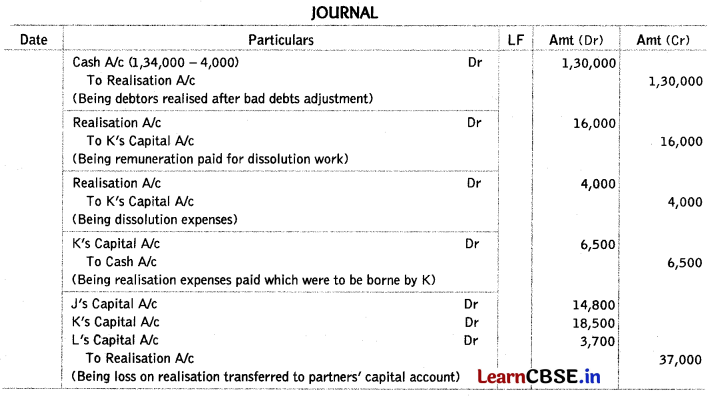
Question 20.
The firm of Manjeet, Sujeet and Jagjeet was dissolved on 31st March, 2018. It was agreed that Sujeet will take care of the dissolution related activities and will get 10% of the value of assets realised, Sujeet agreed to bear the realisation expenses. Assets realised ₹ 10,00,750 and realisation expensed were ₹ 90,000, which were paid from the firm’s cash. ₹ 4,50,000 were paid to the creditors in full settlement of their claim.
Pass necessary journal entries for the above transactions in the books of the firm. (All India 2019)
Answer:
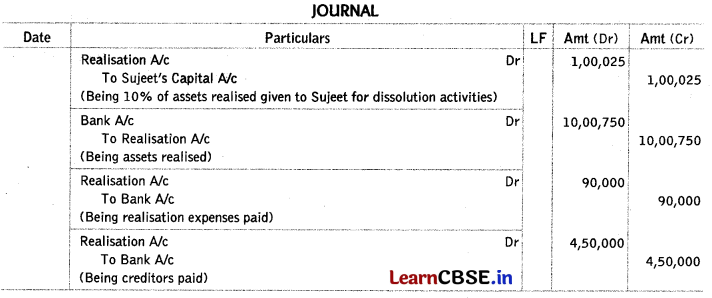
Question 21.
Jain, Sharma and Verma were partners in a firm sharing profits in the ratio of 1 : 2 : 1. On 31st March, 2018 their firm was dissolved. It was agreed that Sharma will look after the dissolution work and will be paid ₹ 15,000 as remuneration. The dissolution expenses were ₹ 5,000. ₹ 2,84,000 were paid to the creditors in full settlement of their claim of ₹ 3,00,000. Dissolution of the firm resulted into a loss of ₹ 18,000. Pass necessary journal entries for the above transactions. (All India 2019)
Answer:
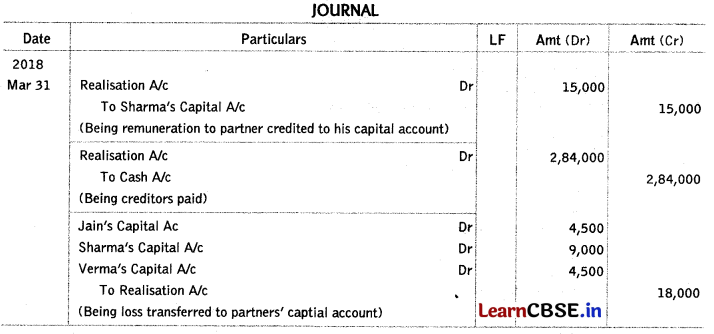
Question 22.
Ravi, Shankar and Madhur were partner in a firm sharing profits in the ratio of 7 : 2 : 1. On 31st March, 2018, the firm was dissolved, after transferring sundry assets (other than cash in hand and cash at bank) and third party liabilities in the realisation accounts the following transactions took place
(i) Debtors amounting to ₹ 1,40,000 were handed over to a debt collection agency which charged 5% commision. The remaining debtors were ₹ 47,000 out of which debtors of ₹ 17,000 could not be recovered because the same become insolvent.
(ii) Creditors amounting to ₹ 5,000 were paid ₹ 3,500 in full settlement of their claim and balance creditors were handed over stock of ₹ 90,000 in full settlement of their claim of ₹ 95,000.
(iii) A bills receivable ₹ 2,000 discounted with the bank was dishonoured by its acceptor and the same had to be met by the firm.
(iv) Profit on realisation amounted to ₹ 6,000. Pass necessary journal entries for the above transactions in the books of Ravi, Shankar and Madhur. (Delhi 2019)
Answer:
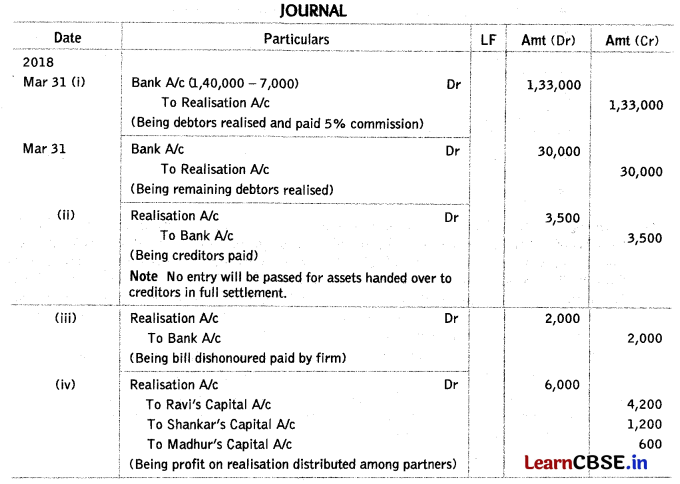
Question 23.
Gaurav, Saurabh and Vaibhav were partners in a firm sharing profits and losses in the ratio of 2 : 2 : 1. They decided to dissolve the firm on 31st March, 2018. After transferring sundry assets (other than cash in hand and cash at bank) and third party liabilities to realisation account, the assets were realised and liabilities were paid-off as follows
(i) A machinery with a book value of ₹ 6,00,000 was taken over by Gaurav at 50% and stock worth ₹ 5,000 was taken over by a creditor of ₹ 9,000 in full settlement of his claim.
(ii) Land and building (book value ₹ 3,00,000) was sold for ₹ 4,00,000 through a broker who charged 2% commission.
(iii) The remaining creditors were paid ₹ 76,000 in full settlement of their claim and the remaining assets were taken over by Vaibhav for ₹ 17,000.
(iv) Bank loan of? 3,00,000 was paid alongwith interest of ₹ 21,000.
Pass necessary journal entries for the above transactions in the books of the firm. (Delhi 2019)
Answer:
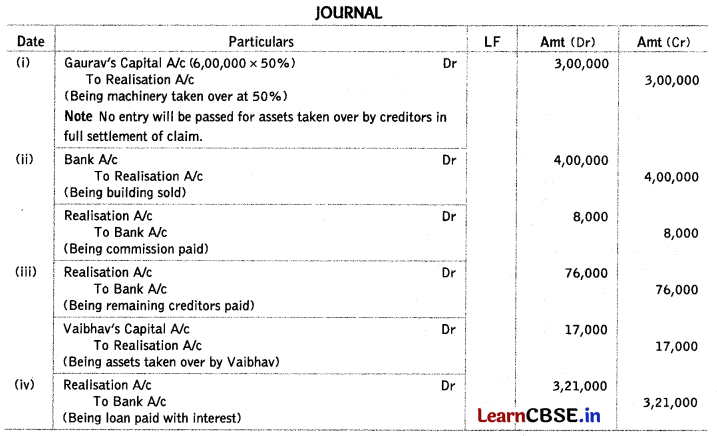
Question 24.
Ankit, Bobby and Kartik were partners in a firm sharing profits in the ratio 4 : 3 : 3. The firm was dissolved on 31-3-2018. Pass the necessary journal entries for the following transactions after various assets (other than cash and bank) and third party liabilities had been transferred to realisation account
(i) The firm had stock of ₹ 80,000. Ankit took over 50% of the stock at a discount of 20% while the remaining stock was sold off at a profit of 30% on cost.
(ii) A liability under a suit for damages included in creditors was settled at ₹ 32,000 as against only ₹ 13,000 provided in the books. Total creditors of the firm were ₹ 50,000.
(iii) Bobby’s sister’s loan of ₹ 20,000 was paid-off alongwith interest of ₹ 2,000.
(iv) Kartik’s loan of ₹ 12,000 was settled at ₹ 12.500.Delhi 2019
Answer:
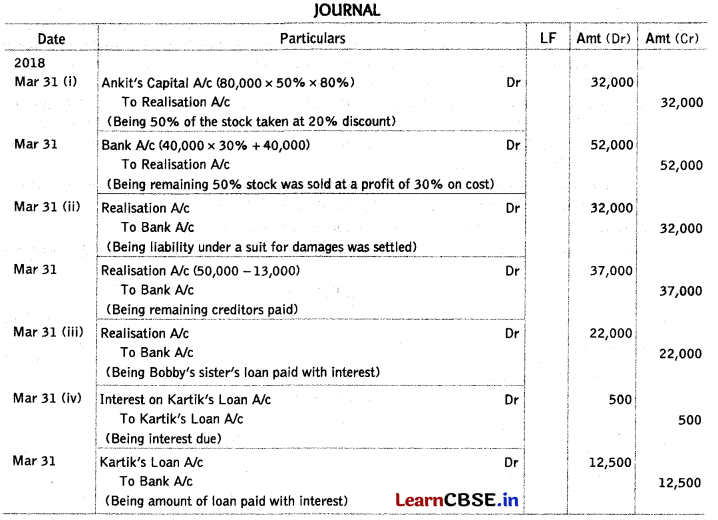
Working Note:
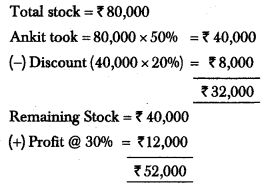
![]()
Question 25.
A, B and C were partners sharing profits and losses in the ratio of 2 : 2 : 1. Their balance Sheet as at 31st March, 2018 was as follows
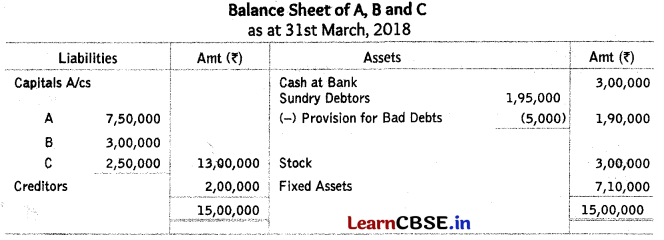
On the above date, they dissolved the firm and following amounts were realised:
Fixed Assets ₹ 6,75,000; Stock ₹ 3,39,000; Debtors ₹ 1,35,000; Creditors were paid ₹ 1,85,000 in full settlement of their claim. Expanses on realisation amounted to ₹ 19,000.
Pass the necessary journal entries on the dissolution of the firm. (All India 2019)
Answer:
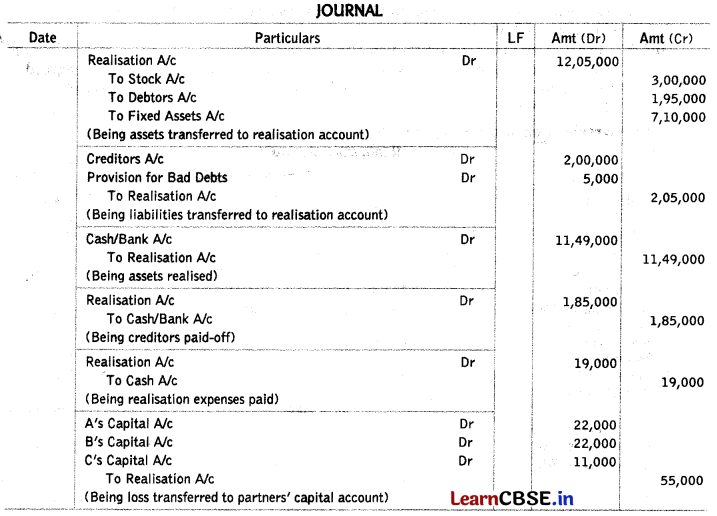
Question 26.
Ashish and Kanav were partners in a firm sharing profits and losses in the ratio of 3 : 2. On 31st March, 2018 their balance sheet was as follows
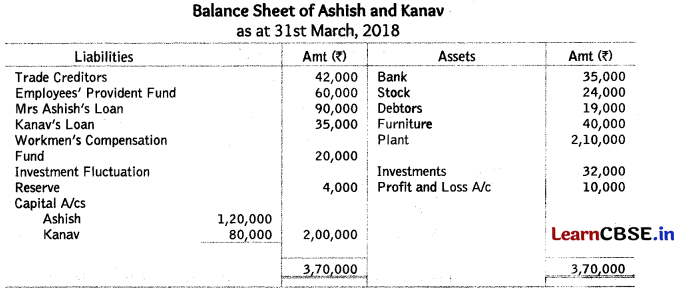
On the above date, they decided to dissolve the firm.
(i) Ashish agreed to take over funriture at ₹ 38,000 and pay-off Mrs Ashish’s loan.
(ii) Debtors realised ₹ 18,500 and plant realised 10% more.
(iii) Kanav took over 40% of the stock at 20% less than the book value. Remaining stock was sold at a gain of 10%.
(iv) Trade creditors took over investments in full settlement.
(v) Kanav agreed to take over the responsibility of completing dissolution at an agreed remuneration of ₹ 12,000 and to bear realisation expenses. Actual expenses of realisation amounted to ₹ 8,000.
Prepare realisation account. (All India 2019)
Answer:
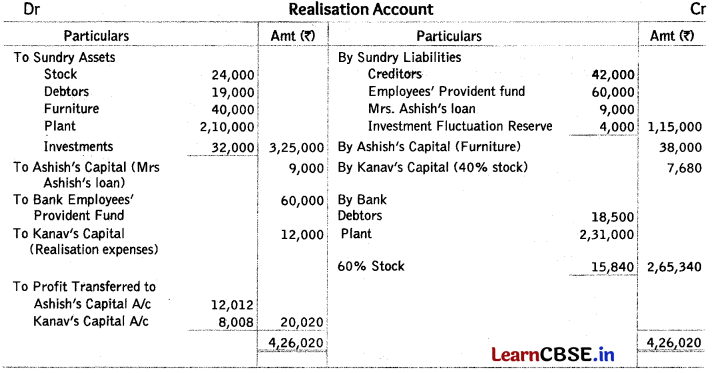
Working Notes:
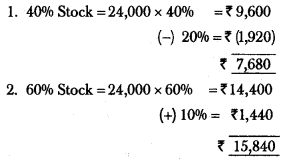
Question 27.
Girija and Ganesh were partners in a firm sharing profits and losses in the ratio of 2 : 3. On 31st March, 2018 their balance sheet was as follows
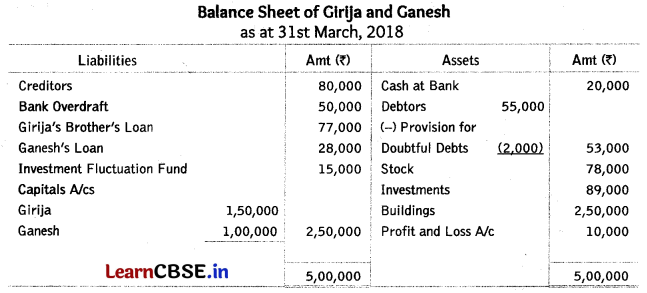
On the above date, the firm was dissolved. The assets were realised and the liabilities were paid-off as follows
(i) Debtors of ₹ 6,000 were proved bad.
(ii) Girija agreed to pay-off her brother’s loan.
(iii) One of the creditors for ₹ 10,000 was paid only ₹ 3,000 in full settlement of his account.
(iv) Buildings were auctioned for ₹ 1,80,000 and the auctioneer’s commission amounted to ₹ 1,80,000 and the auctioneer’s commission amounted to ₹ 8,000.
(v) Ganesh took over part of stock at ₹ 4,000 (being 20% less than the book value). Balance of the stock was handed over to the remaining creditors in full settlement of their account.
(vi) Investments realised ₹ 9,000 less.
(vii) Realisation expenses amounted to ₹ 17,000 and were paid by Ganesh.
Prepare realisation account, partners’ capital accounts and bank account. (compartment 2018)
Answer:
Solve as Q. no. 46 on page 261 and 262.
Loss on Realisation-Girija = ₹ 36,000
Ganesh = ₹ 54,000
Parmer’s Capital A/c-Cash paid to Girija = ₹ 1,87,000
Cash paid to Ganesh = ₹ 53,000
Bank A/c- ₹ 3,21,000
Question 28.
Pass necessary journal entries on the dissolution of a partnership firm in the following cases
(i) Dissolution expenses were ₹ 800.
(ii) Dissolution expenses ₹ 800 were paid by Prabhu, a partner.
(iii) Geeta, a partner, was appointed to look after the dissolution work, for which she was allowed a remuneration of ₹ 10,000. Geeta agreed to bear the dissolution expenses. Actual dissolution expenses ₹ 9,500 were paid by Geeta.
(iv) Janki, a partner, agreed to look after the dissolution work for a commission of ₹ 5,000. Janki agreed to bear the dissolution expenses. Actual dissolution expenses ₹ 5,500 were paid by Mohan, another partner, on behalf of Janki.
(v) A partner, Kavita, agreed to look after the dissolution process for a commission of ₹ 9,000. She also agreed to bear the dissolution expenses. Kavita took over furniture of ₹ 9,000 for her commission. Furniture had already been transferred to realisation account.
(vi) A debtor, Ravinder, for ₹ 19,000 agreed to pay the dissolution expenses which were ₹ 18,000 in full settlement of his debt. (All India 2017)
Answer:
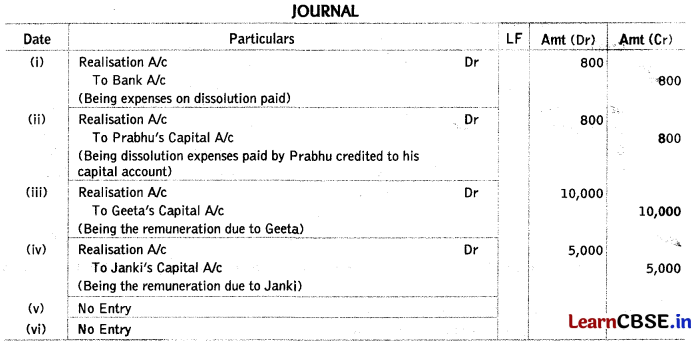
Question 29.
Pass necessary journal entries on the dissolution of a partnership firm in the following cases
(i) L, a partner, was appointed to look after the dissolution process for which he was given a remuneration of ₹ 10,000.
(ii) Dissolution expenses ₹ 8,000 were paid by the partner M.
(iii) Dissolution expenses were ₹ 5,000.
(iv) P, a partner, was appointed to look after the process of dissolution for which he was allowed a remuneration of ₹ 7,000. P agreed to bear the dissolution expenses. Actual dissolution expenses ₹ 4,000 were paid by P.
(v) N, a partner, was appointed to look after the process of dissolution for which he was allowed a remuneration of ₹ 9,000. N agreed to bear the dissolution expenses. Actual
dissolution expenses ₹ 4,000 were paid by the firm.
(vi) Q, a partner, was appointed to look after the process of dissolution for which he was allowed a remuneration of ₹ 18,000. Q agreed to take over stock worth ₹ 18,000 as his remuneration. The stock had already been transferred to realisation account. (Delhi 2017)
Ans.
For points (ii), (in), (iv) and (vi). Solve as Q no. 28 on page 240.

Question 30.
Lai and Pal were partners in a firm sharing profits in the ratio of 3 : 7. On 1st April, 2015, their firm was dissolved. After transferring assets (other than cash) and outsider’s liabilities to realisation account, you are given the following information.
(i) A creditor of ₹ 3,60,000 accepted machinery valued at ₹ 5,00,000 and paid to the firm ₹ 1,40,000.
(ii) A second creditor for ₹ 50,000 accepted stock at ₹ 45,000 in full settlement of his claim.
(iii) A third creditor amounting to ₹ 90,000 accepted ₹ 45,000 in cash and investments worth ₹ 43,000 in full settlement of his claim.
(iv) Loss on dissolution was ₹ 15,000.
Pass necessary journal entries for the above transactions in the books of firm assuming that all payments were made by cheque. (All India 2016)
Answer:
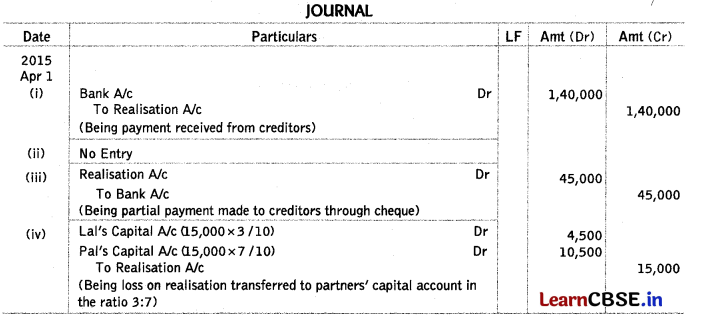
Question 31.
L and M were partners in a firm sharing profits in the ratio of 2 : 3. On 28th February, 2016, the firm was dissolved. After transferring assets (other than cash) and outsiders’ liabilities to realisation account you are given the following information.
(i) A creditor for ₹ 1,40,000 accepted building valued at ₹ 1,80,000 and paid to the firm ₹ 40,000.
(ii) A second creditor for ₹ 30,000 accepted machinery valued at ₹ 28,000 in full settlement of his claim.
(iii) A third creditor amounting to ₹ 70,000 accepted ₹ 30,000 in cash and investments of the book value of ₹ 45,000 in full settlement of his claim.
(iv) Loss on dissolution was ₹ 4,000.
Pass necessary journal entries for the above transactions in the books of the firm assuming that all payments were made by cheque. (Delhi 2016)
Answer:
Solve as Q no. 28 on page 240.
Question 32.
Mala, Neela and Kala were partners sharing profits in the ratio of 3 : 2 : 1. On 1st March, 2015, their firm was dissolved. The assets were realised and liabilities were paid-off. The accountant prepared realisation account, partners’ capital account and cash account, but forgot to post few amounts in these accounts.
You are required to complete these below given accounts by posting correct amounts.
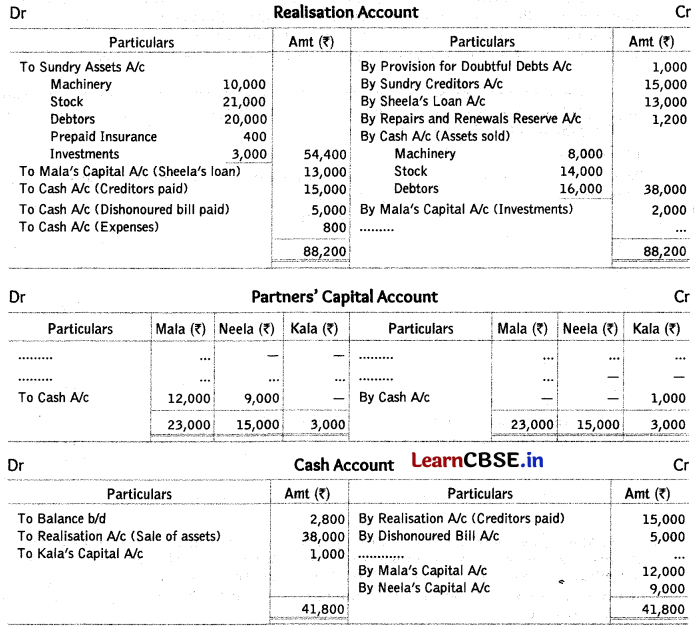
Answer:
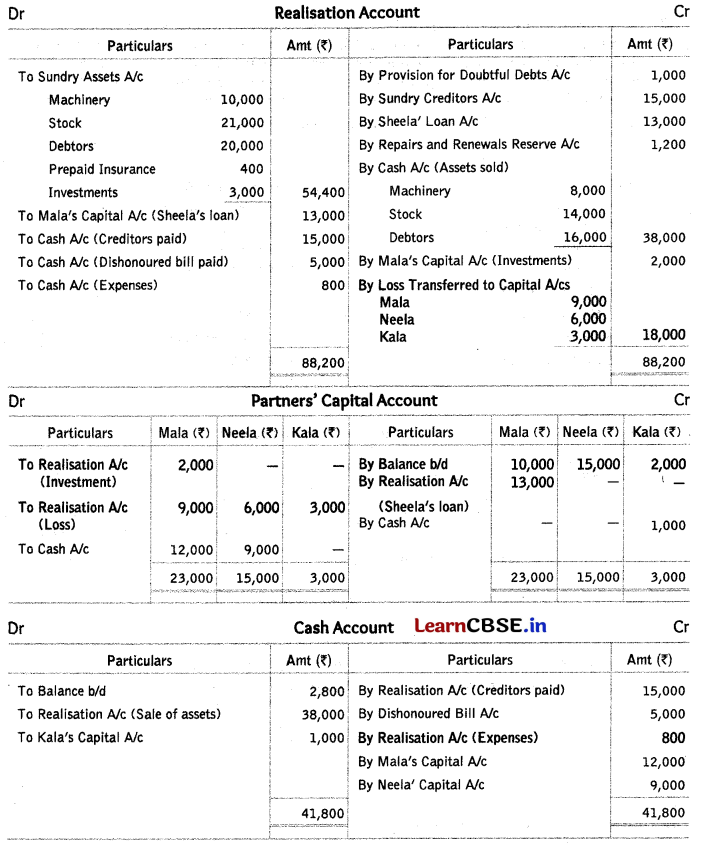
Question 33.
Bora, Singh and Ibrahim were partners in a firm sharing profits in the ratio 5 : 3 : 1. On 2nd March, 2015, their firm was dissolved. The assets were realised and the liabilities were paid-off. Given below are the realisation account, partners’ capital accounts and bank account of the firm. The accountant of the firm left a few amounts unposted in these accounts. You are required to complete these accounts by posting the correct amounts.
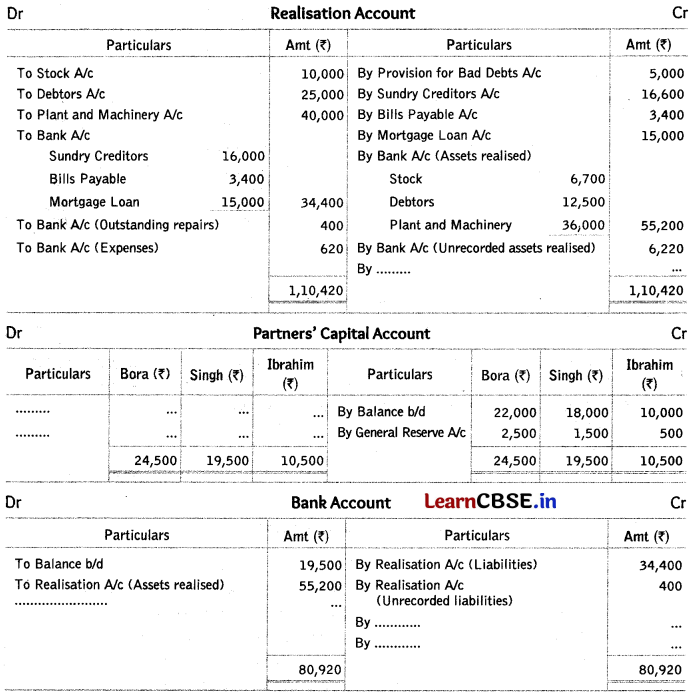
Answer:
Solve as Q no. 32 on page 242 and 243.
Loss on Realisation : Bora = ₹ 5,000, Singh = ₹ 3,000, Ibrahim = ₹ 1,000; Total of Bank Account = ₹ 80,920.
![]()
Question 34.
Bhuvan, Suraj and Ibrahim were partners in a firm sharing profits in the ratio of 3 : 2 : 1. On 30th June, 2014, they decided to dissolve the firm. Following was the balance sheet of the firm on that date.

The assets were realised and the liabilities were paid-off as follows
(i) Investments were taken over by Bhuvan for ₹ 18,000.
(ii) Stock was taken over by Suraj for ₹ 17,500 and furniture was taken over by Ibrahim at book value.
(iii) ₹ 60,500 were realised from the debtors.
(iv) Creditors were settled in full and realisation expenses were ₹ 4,500.
Prepare realisation account, cash account and partners’ capital accounts. (All Indio (C) 2015)
Answer:
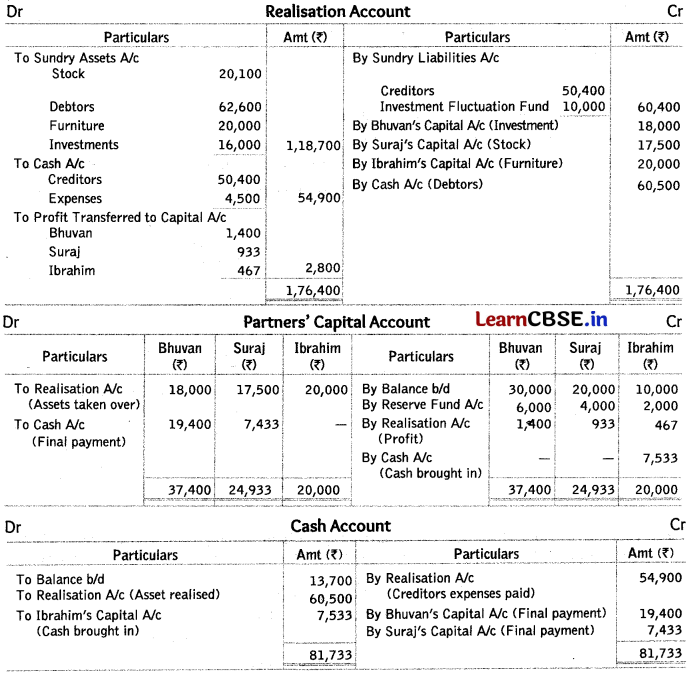
Question 35.
Parth and Shivika were partners in a firm sharing profits in the ratio of 3 : 2. The balance sheet of the firm on 31st March, 2014, was as follows

On the above date, the firm was dissolved. The assets were realised and the liabilities were paid-off as follows
(i) 50% of the furniture was taken over by Parth at 20% less than book value. The remaining furniture was sold for ₹ 1,05,000.
(ii) Debtors realised ₹ 26,000.
(iii) Stock was taken over by Shivika for ₹ 29,000.
(iv) Shivika’s sister’s loan was paid-off alongwith an interest of ₹ 2,000.
(a) Expenses on realisation amounted to ₹ 5,000.
Prepare realisation account, partners’ capital accounts and bank account. (Delhi 2015)
Answer:
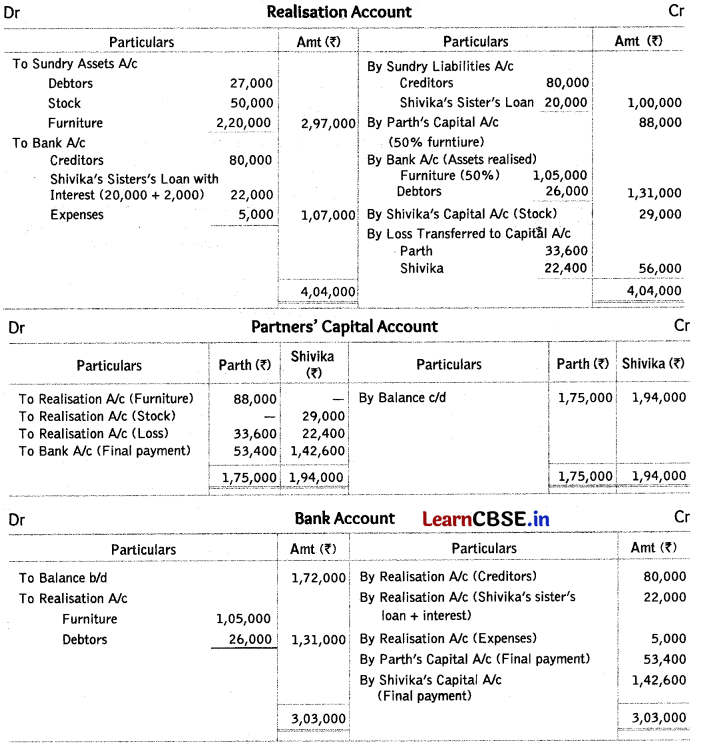
Question 36.
Hanif and Jubed were partners in a firm sharing profits in the ratio of their capitals. On 31st March, 2013, their balance sheet was as follows
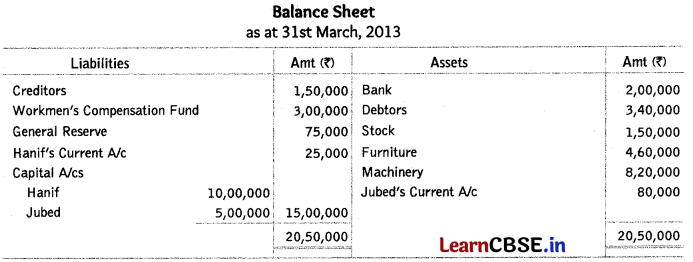
On the above date, the firm was dissolved
(i) Debtors were realised at a discount of 5%. 50% of the stock was taken over by Hanif at 10% less than the book value. Remaining stock was sold for ₹ 65,000.
(ii) Furniture was taken over by Jubed for ₹ 1,35,000. Machinery was sold as scrap for ₹ 74,000.
(iii) Creditors were paid in full.
(iv) Expenses on realisation ₹ 8,000 were paid by Hanif. Prepare realisation account. (All India 2014)
Answer:
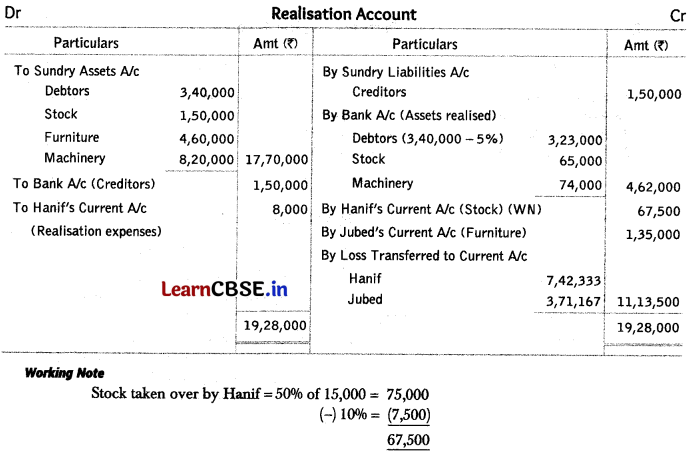
Question 37.
Shanti and Satya were partners in a firm sharing profits in the ratio of 4 : 1. On 31st March, 2013, their balance sheet was as follows
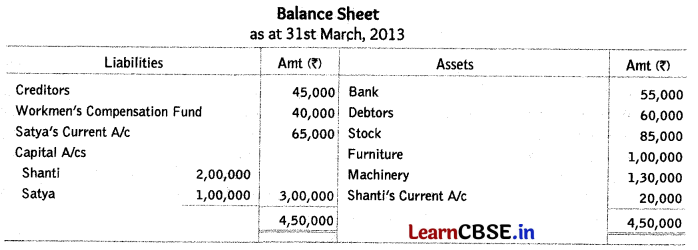
On the above date, the firm was dissolved
(i) Shanti took over 40% of the stock at 10% less than its book value and the remaining stock was sold for ₹ 40,000. Furniture realised ₹ 80,000.
(ii) All unrecorded investment was sold for ₹ 20,000. Machinery was sold at a loss of ₹ 60,000.
(iii) Debtors realised ₹ 55,000.
(iv) There was an outstanding bill for repairs for which ₹ 19,000 were paid.
Prepare realisation account. (Delhi 2014)
Answer:
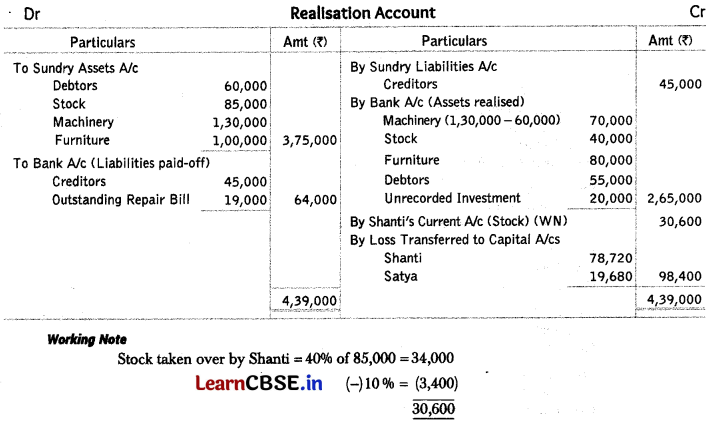
Question 38.
Verma and Sharma were partners sharing profits in the ratio of 3 : 1. On 31st March, 2011, their balance sheet was as follows

The firm was dissolved on 1st April, 2011 and the assets and liabilities were settled as follows
(i) Creditors of ₹ 50,000 took over land and building in full settlement of their claim.
(ii) Remaining creditors were paid in cash.
(iii) Machinery was sold at a depreciation of 30%.
(iv) Debtors were collected at a cost of ₹ 500.
(v) Expenses on realisation were ₹ 1,700.
Pass necessary journal entries for dissolution of the firm. (Delhi 2012)
Answer:
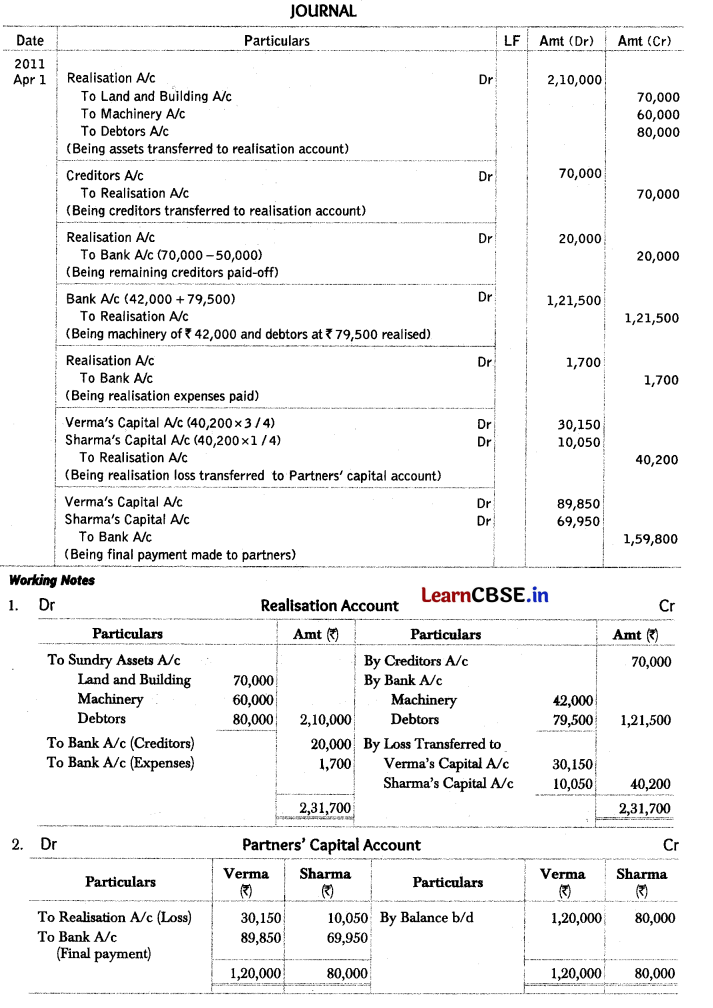
3. No entry is required for adjustment (i), since creditors have accepted the asset (land and Building) in full and final settlement.
Question 39.
A and B were partners in a firm sharing profits in the ratio of 3 : 2. On 31st March, 2011, the balance sheet of the firm was as follows

The firm was dissolved on 1st April, 2011 and the assets and liabilities were settled as follows
(i) Building was taken over by creditors as their full and final payment.
(ii) Furniture was taken over by B for cash payment at 5% less than the book value.
(iii) Debtors were collected by a debt collection agency at a cost of f5,000.
(iv) Stock realised ₹ 70,500.
(v) B agreed to bear all realisation expenses. For this service, B is paid ₹ 500. Actual expense on realisation amounted to ₹ 1,000.
Pass necessary journal entries for dissolution of the firm. (Delhi 2012)
Answer:

3. No entry is required for adjustment (i), since creditors have accepted the asset (Building) in full and final settlement.
Question 40.
Sanjay and Sameer were partners in a firm sharing profits in the ratio of 2 : 3. On 31st March, 2011, the balance sheet of the firm was as follows

The firm was dissolved on 1st April, 2011 and the assets and liabilities were settled as follows
(i) Sanjay agrees to take over land and building at ₹ 3,50,000 by paying cash.
(ii) Stock was sold for ₹ 90,000.
(iii) Creditors accepted debtors in full settlement of their claim.
Pass necessary journal entries for dissolution of the firm. (All India 2012)
Answer:
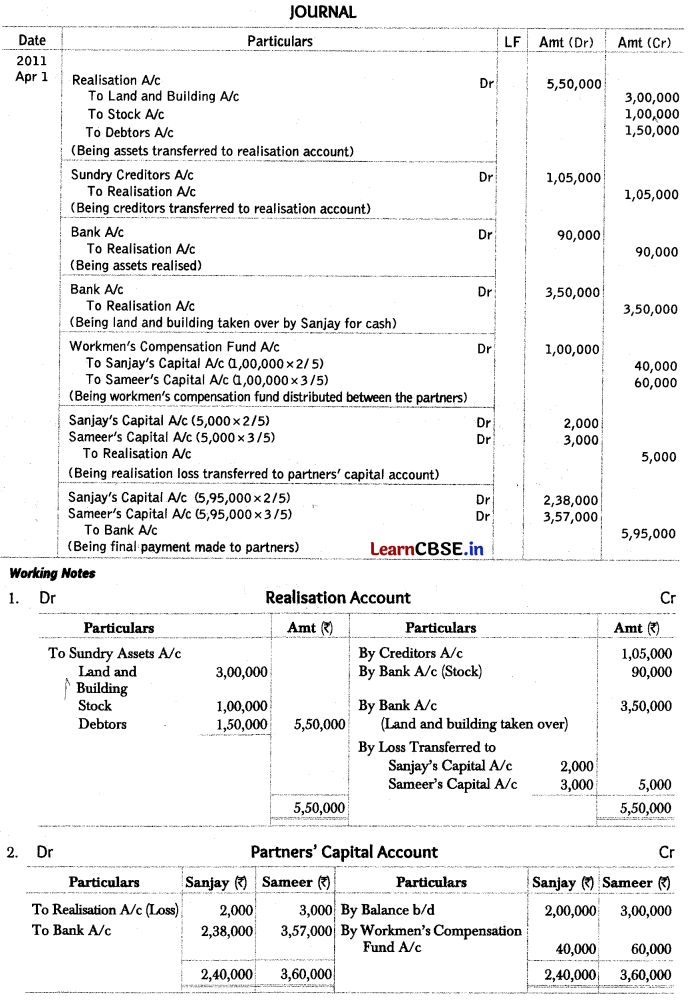
3. No entry is required for adjustment (iii), since creditors have accepted debtors in full and final settlement
Question 41.
Achal and Vichal were partners in a firm sharing profits in the ratio of 3 : 5. On 31st March, 2011, their balance sheet was as follows

The firm was dissolved on 1st April, 2011 and the assets and liabilities were settled as follows
(i) Land and building realised ₹ 4,30,000.
(ii) Debtors realised ₹ 2,25,000 (with interest) and ₹ 1,000 were recovered for bad debts written-off last year.
(iii) There was an unrecorded investment which was sold for ₹ 25,000.
(iv) Vichal took over machinery at ₹ 2,80,000 for cash.
(v) 50% of the creditors were paid ₹ 4,000 less in full settlement and the remaining creditors were paid full amount.
Pass necessary journal entries for dissolution of the firm. (All India 2012)
Answer:
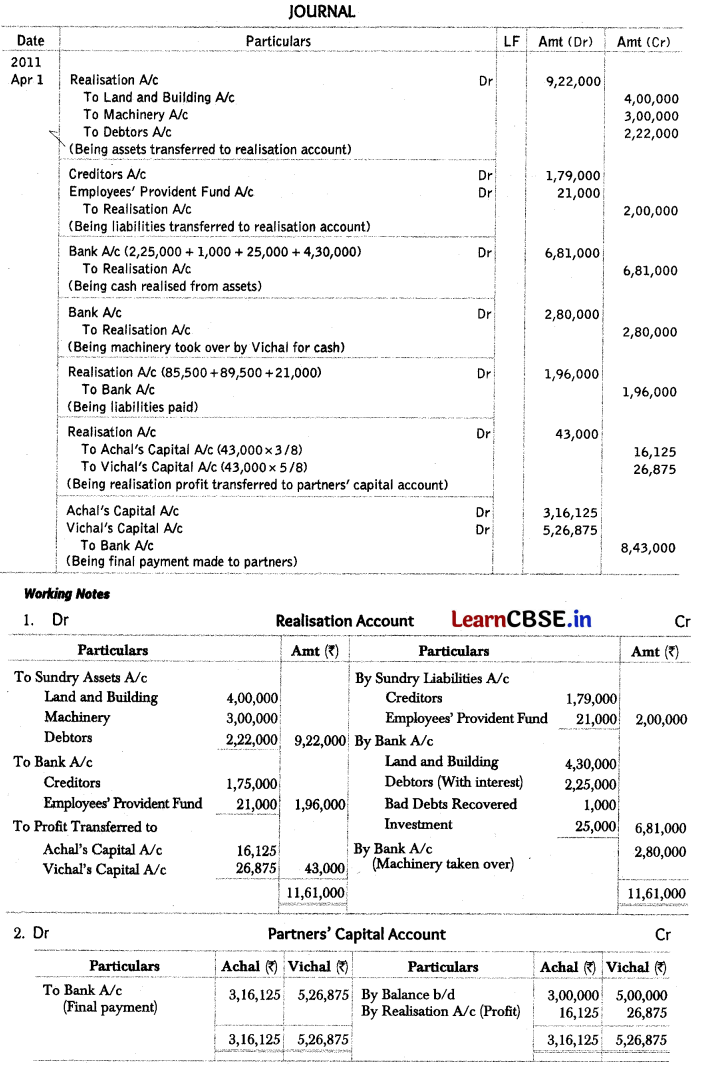
Question 42.
Pass the necessary journal entries for the following transactions on the dissolution of the firm of P and Q after the various assets (other than cash) and outside liabilities have been transferred to realisation account.
(i) Bank loan ₹ 12,000 was paid.
(ii) Stock worth ₹ 16,000 was taken over by a partner Q.
(iii) Partner P paid a creditor ₹ 4,000.
(iv) An asset not appearing in the books of accounts realised ₹ 1,200.
(v) Expenses of realisation ₹ 2,000 were paid by partner Q.
(vi) Profit on realisation ₹ 36,000 was distributed between P and Q in 5 : 4 ratio. Delhi 2011
Answer:
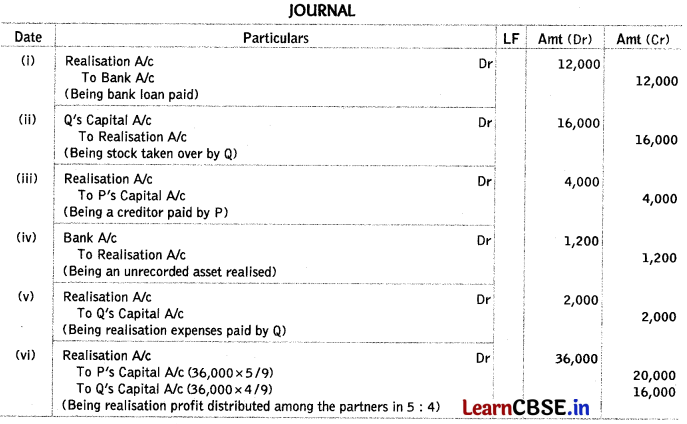
![]()
Question 43.
Pass the necessary journal entries for the following transactions on the dissolution of the firm of James and Haider who were sharing profits and losses in the ratio of 2 : 1. The various assets (other than cash) and outside liabilities have been transferred to realisation account.
(i) James agreed to pay off his brother’s loan ₹ 10,000.
(ii) Debtors realised ₹ 12,000.
(iii) Haider took over all investment at ₹ 12,000.
(iv) Sundry creditors ₹ 20,000 were paid at 5% discount.
(v) Realisation expenses amounted to ₹ 2,000.
(vi) Loss on realisation was ₹ 10,200. (All India 2011)
Answer:
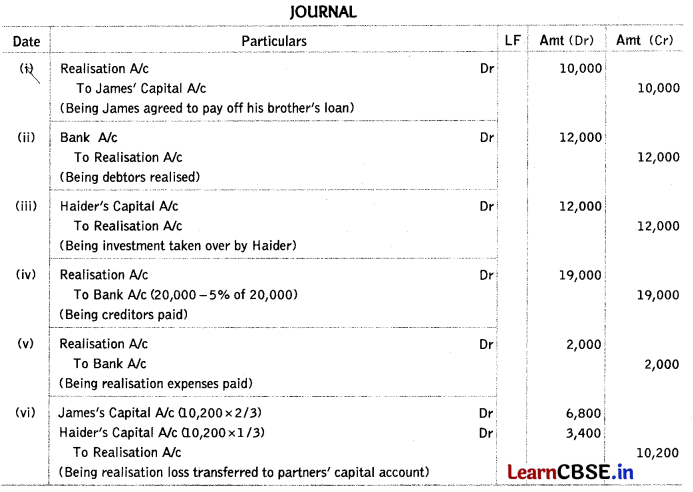
Question 44.
Srijan, Raman and Manan were partners in a firm sharing profits and losses in the ratio of 2 : 2 : 1. On 31st March, 2017 their balance sheet was as follows
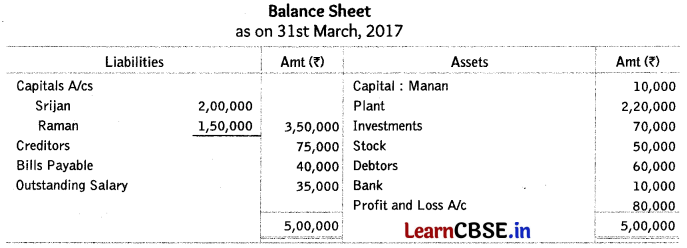
On the above date, they decided to dissolve the firm.
(i) Srijan was appointed to realise the assets and discharge the liabilities. Srijan was to receive 5% commission on sale of assets (except cash) and was to bear all expenses of realisation.
(ii) Assets were realised as follows
Plant – 85,000
Stock – 33,000
Debtors – 47,000
(iii) Investments were realised at 95% of the book value.
(iv) The firm had to pay ₹ 7,500 for an outstanding repair bill not provided for earlier.
(v) A contingent liability in respect of bills receivable, discounted with the bank had also materialised and had to be discharged for ₹ 15,000.
(vi) Expenses of realisation amounting to ₹ 3,000 were paid by Srijan.
Prepare realisation account, partners’ capital accounts and bank account. (CBSE 2018)
Answer:
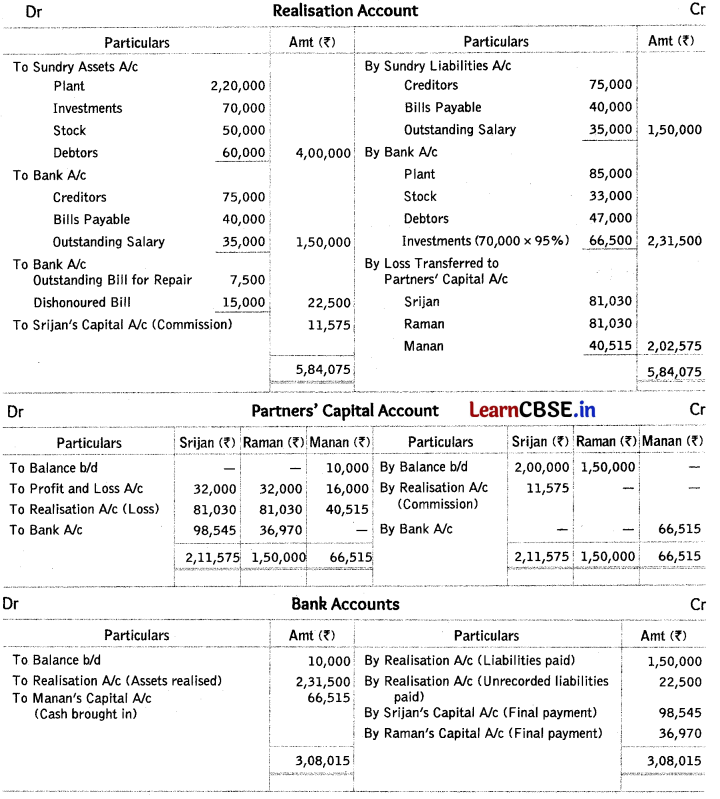
Working Note:
Commission payable to Srijan = 2,31,500 × \(\frac { 5 }{ 100 }\) = ₹ 11,575
Question 45.
Arnab, Ragini and Dhrupad are partners sharing profits in the ratio of 3 : 1 : 1. On 31st March, 2015 they decided to dissolve their firm. On that date, their balance sheet was as under
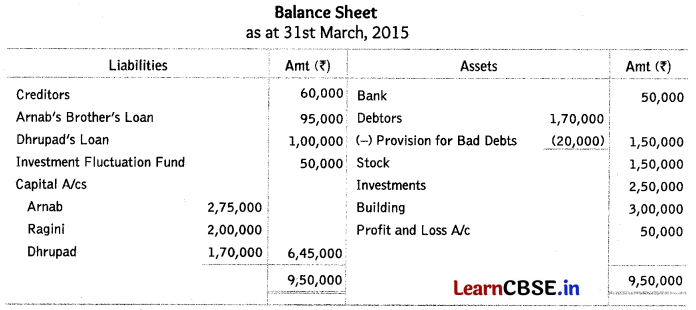
The assets were realised and the liabilities were paid as under
(i) Arnab agreed to pay his brother’s loan.
(ii) Investments realised 20% less.
(iii) Creditors were paid at 10% less.
(iv) Building was auctioned for ₹ 3,55,000. Commission on auction was ₹ 5,000.
(v) 50% of the stock was taken over by Ragini at market price which was 20% less than the book value and the remaining was sold at market price.
(vi) Dissolution expenses were ₹ 8,000. ₹ 3,000 were to be borne by the firm and the balance by Dhrupad. The expenses were paid by him.
Prepare realisation account, bank account and partners’ capital accounts. (All India 2016)
Answer:
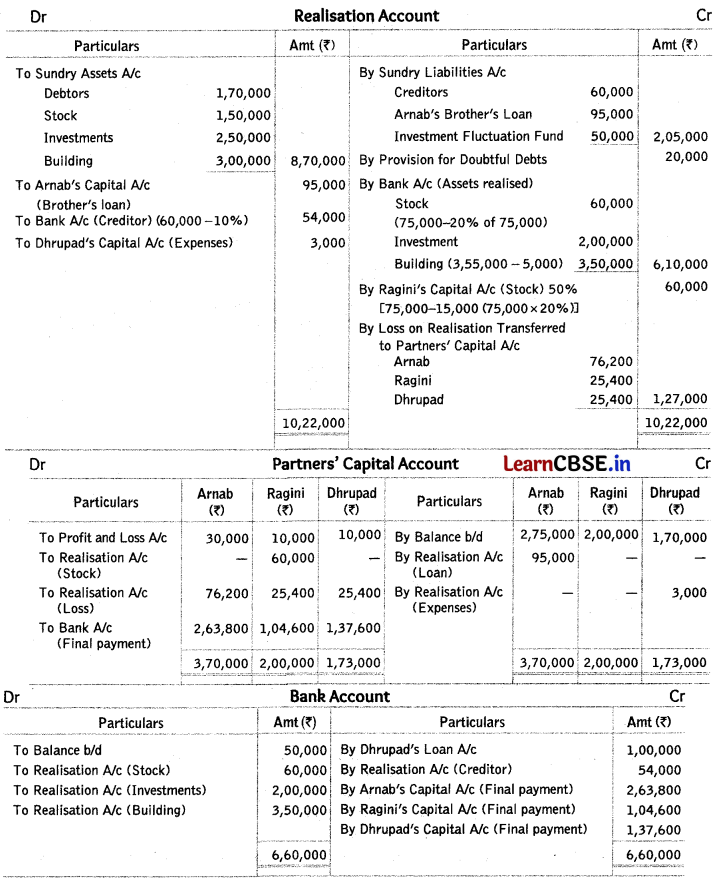
Question 46.
Following is the balance sheet of Vinit and Yogesh as on 31st March, 2015.
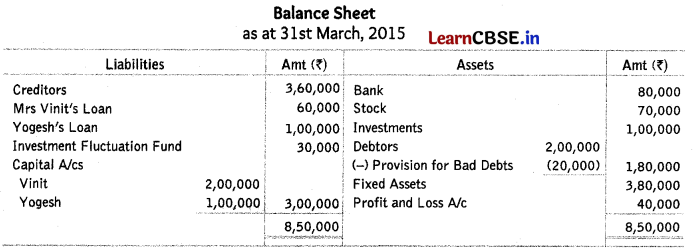
The firm was dissolved on 31st March, 2015. The assets were realised and the liabilities were paid as under
(i) Vinit promised to pay-off Mrs Vinit’s loan and took away stock at 20% discount.
(ii) Yogesh took away 90% of the investments at 10% discount.
(iii) Sunil, a debtor of ₹ 50,000 had to pay the amount due 3 months after the date of dissolution. He was allowed a discount of 5% for making payment immediately. The remaining debtors were collected in full.
(iv) Creditors were paid ₹ 3,50,000 in full settlement of their claim.
(v) Fixed assets realised ₹ 2,82,000 and remaining investment realised ₹ 7,500.
(vi) There was an old furniture which had been written-off completely from the books. Yogesh took away the same for ₹ 4,000.
(vii) Realisation expenses ₹ 2,000 were paid by Vinit.
Prepare realisation account, bank account and partners’ capital accounts. (Delhi (C) 2016)
Answer:
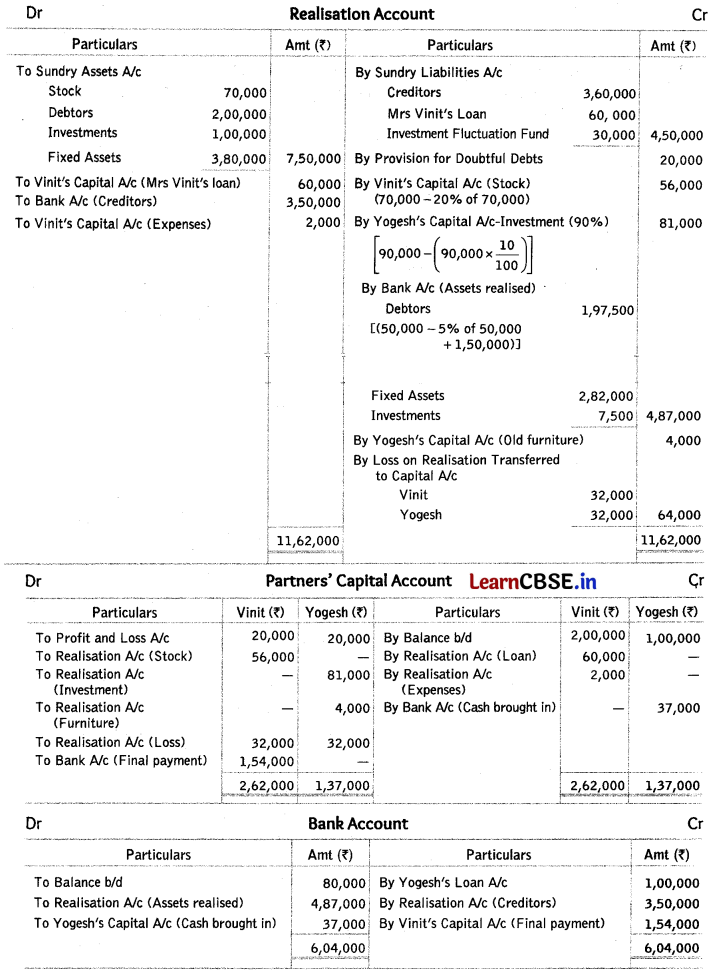
Question 47.
Kumar, Shyam and Ratan were partners in a firm sharing profits in the ratio of 5 : 3 : 2 respectively. They decided to dissolve the firm with effect from 1st April, 2013. On that date, the balance sheet of the firm was as follows

The dissolution resulted in the following
(i) Plant of ₹ 40,000 was taken over by Kumar at an agreed value of? 45,000 and remaining plant realised ₹ 50,000.
(ii) Furniture realised ₹ 40,000.
(iii) Motor van was taken over by Shyam for ₹ 30,000.
(iv) Debtors realised ₹ 1,000 less.
(v) Creditors for ₹ 20,000 were untraceable and the remaining creditors were paid in full.
(vi) Realisation expenses amounted to ₹ 5,000.
Prepare the realisation account, capital accounts of partners and bank account of the firm. (All India (C) 2014)
Answer:
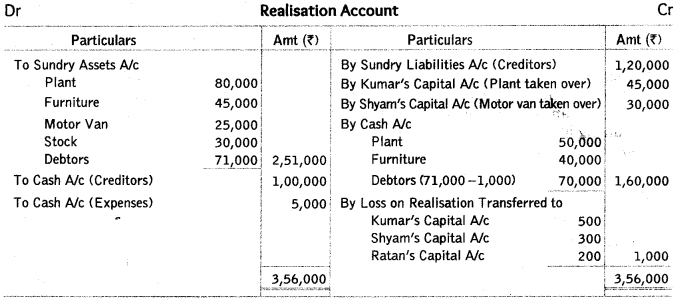
NOTE; In the absence of any information, it has been assumed that nothing is realised from stock.
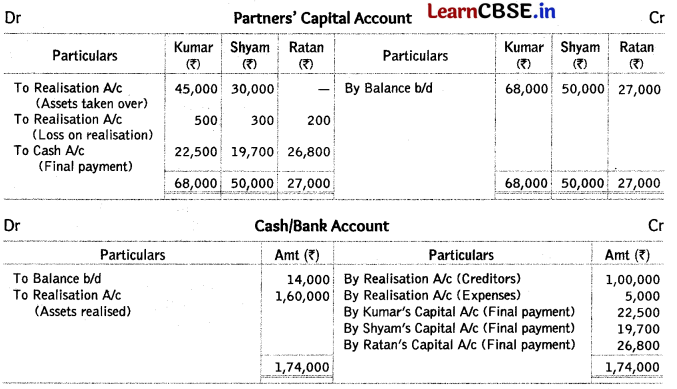
Question 48.
………… refers to the change in the existing relationship between partners but the firm may continue its business as before.
(a) Dissolution of partnership
(b) Dissolution of firm
(c) Either (a) or (b)
(d) None of the above
Answer:
(a) Dissolution of partnership
![]()
Question 49.
According to …………… of the Indian Partnership Act, 1932, dissolution of the firm means dissolution of partnership among all the partners in the firm.
(a) Section 38
(b) Section 40
(c) Section 39
(d) Section 42
Answer:
(c) Section 39
Question 50.
In case of dissolution Of a firm, which item on the liabilities side is to be paid last?
(a) Creditors
(b) Bank loan
(c) Partners loan
(d) Partners capital
Answer:
(d) Partners capital
Question 51.
According to Section 49 of the Indian Partnership Act, 1932, “Firm’s property is first applied for the …………… and if surplus is left then it is utilised for the payment of partners’ private debts.”
(a) payment of firm’s debt
(b) personal expenses
(c) Partners share
(d) None of the above
Answer:
(a) payment of firm’s debt
Question 52.
Profit/Loss on realisation is transferred to the
(a) profit and loss adjustment account
(b) partners’ capital account
(c) Both (a) and (b)
(d) None of the above
Answer:
(b) partners’ capital account
Question 53.
Realisation account is a
(a) nominal account
(b) real account
(c) personal account
(d) None of these
Answer:
(a) nominal account
Question 54.
In the books of XY firm, there was an unrecorded asset of ₹ 10,000. This asset realised for ₹ 12,000. In the realisation account
(a) cash account will be credited by ₹ 10,000
(b) cash account will be credited by ₹ 12,000
(c) cash account will be debited by ₹ 2,000
(d) None of the above
Answer:
(b) cash account will be credited by ₹ 12,000
Question 55.
Which account is prepared only once during the life of a partnership firm?
(a) Revaluation account
(b) Realisation account
(c) Partners capital account
(d) Profit and loss appropriation account
Answer:
(b) Realisation account
Question 56.
‘E’ and ‘F’ were partners sharing profits equally. They decided to dissolve the firm. The goodwill was taken over by ‘E’ at an agreed value of ₹ 54,000. The required journal entry will be
(a) Cash A/c Dr
To Realisation A/c
(b) ‘E’s’ Capital A/c Dr
To Realisation A/c
(c) Realisation A/c Dr
To ‘E’s’ Capital A/c
(d) None of the above
Answer:
(b) ‘E’s’ Capital A/c Dr
To Realisation A/c
Question 57.
The amount of sundry assets transferred to realisation account was ₹ 80,000, 60% of them were sold at a profit of ₹ 2000. 20% of the remaining were sold at a discount of 30% and remaining were taken over by ‘Z’ at book value. The amount realised from assets is
(a) ₹ 54,480
(b) ₹ 25,600
(c) ₹ 80,000
(d) ₹ 80,080
Answer:
(d) ₹ 80,080
![]()
Question 58.
Loan from partner is deemed to be an …………. liability at the time of dissolution.
(a) external
(b) internal
(c) not a liability
(d) None of these
Answer:
(b) internal
Question 59.
Rohit, a partner agreed to take over the responsibility of completing dissolution at an agreed remuneration of ₹ 4,000 and to bear all realisation expenses. Actual realisation expenses of ₹ 3,200 were paid by Rohit out of his private funds. In realisation account, Rohit’s capital account will be
(a) debited with ₹ 4,000
(b) debited with ₹ 3,200
(c) credited with ₹ 4,000
(d) credited With ₹ 3,200
Answer:
(a) debited with ₹ 4,000